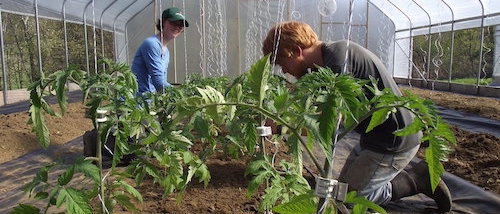From the time you get seed catalogs, order seeds, plant out plugs and seeds, water, weed, fertilize and finally harvest your flowers, you need to know where they are going to be sold. For most people it is growing of flowers that draws us in, not selling flowers. Rarely does someone say I love selling flowers so maybe I should grow them, too.
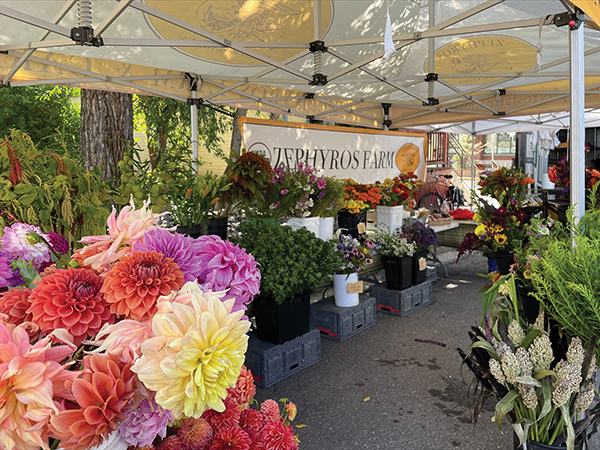 The author’s farmers market stand. All photos courtesy of the author.
The author’s farmers market stand. All photos courtesy of the author.
If you’re lucky, you like to sell, have sales experience, or have the right personality for selling flowers. If not, hire someone who does. Either way it is important to carefully consider your market well before the first seed is ordered.
I will discuss the different markets from what I consider the easiest to the most difficult from our experiences at Zephyros Farm and Garden in western Colorado. Of course, all of this is context dependent on your competition, your market size, your market demographics, and the skills you bring to the table or are willing to hire for. For some wholesale might seem much easier than a CSA. It may be, but florists generally are less forgiving. But certain CSA customers can be quite unforgiving as well. So this first of two articles on flower marketing will focus on farmers markets and CSAs with the second on wholesale and weddings.
Farmers markets
To me, the easiest way to start selling flowers is at a farmers market or other weekly market in your area. Farmers markets done well can also be quite difficult and take a lot of time, energy and commitment. But to get your feet wet and meet the public with your products, it can be done with a simple table, tent, tablecloth and a cash envelope. If you are not good at making bouquets, you can sell by the bunch or stem. If you are ready to give bouquets a shot or have experience with design, then it is a great place to sell bouquets.
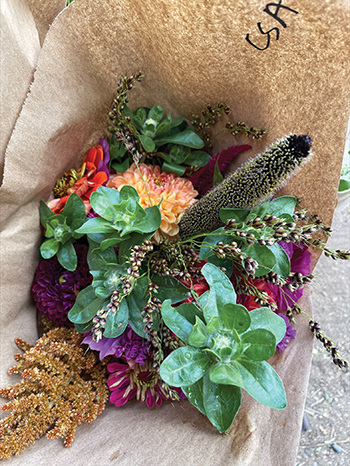 Examples of the author’s CSA bouquets. They offer on-farm pickup, and have one off-farm CSA pickup location. Off-farm pickup costs more to account for transportation.
Examples of the author’s CSA bouquets. They offer on-farm pickup, and have one off-farm CSA pickup location. Off-farm pickup costs more to account for transportation.
We started with a 10x10 booth about half flowers and half vegetables. As we always sold the flowers and not all the kale, we started to bring more and more flowers. Our bouquets sold well and allowed us to use up all the stems that are less desirable sold individually. Fast forward 20 years, we now have 50 feet of booth space. Except during tomato season, we fill it full of flowers. We do three markets a week.
Here are lessons we learned along the way and the elements that we feel drive sales. In the vegetable world they say stack it high and watch it fly. If you only put out three bunches of carrots no one will buy them, but if you put out 60 you will sell all but the last three. It is the same with flowers. Full buckets of flowers, full bouquet stands, and diversity in color and styles has been key. No matter the design you need a full booth that looks abundant. We have a stand for large bouquets, two for medium, then on the tables are the little and minis. We have two stepped racks to display our stems as well as tables with tablecloths over crates for a stepped look.
Bouquets
Selling bouquets you must define your style and know that your market also will define that for you. We see some who sell one type of bouquet, one size of bouquet, with the same flowers, same mix, same colors. If your market is cheap or you only have limited flowers, this can be a good way to go as the bouquet making process is faster and you can sell them for less with less time invested. The old Arnosky adage, “Every time you touch a flower it costs money,” holds true.
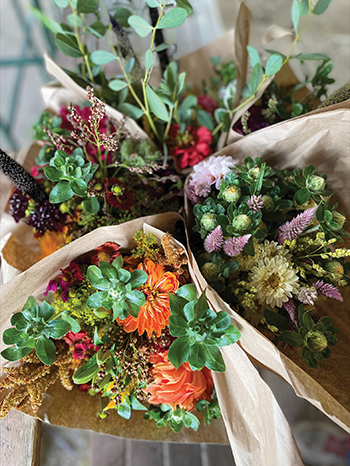
No matter your style we think it has been key to offer different sizes. We sell large for $60 and medium table bouquets for $30. A “little miss” sells for $15 and we always have bunches of small flowers — think sweet peas, gomphrena, ping pong scabiosas — we sell for $5 or $7. Don’t focus on the price, your market may be different. What is important is the range of prices. Someone might look at $30 and think, “Wow that is a lot,” but then see the $60 and say, “Oh, I guess not so bad.”
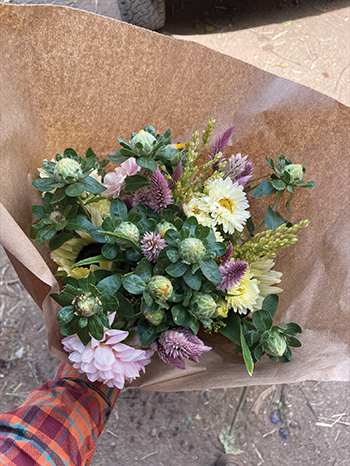
You do have to have these different sizes to be distinct. If you can’t pick one up and not know immediately which size it is, you have a problem. Finally we say we can make a custom bouquet but that starts at $65. There is always a bouquet for everyone. If a customer only has $5 they can have a quick bunch. If the mother in law is coming over it’s time to get the big bouquet. Often people buy more than one, perhaps for a table and a few more for their guest bathroom.
We can charge these prices and sell a ton as we have put a lot of time, energy and money into learning design. We have a variety of color pallets that sell well, and there are several different bouquets in each bucket. Our bouquet stands are always full of a variety of designs and colors.
We know one market loves white, yellow, green with hints of purple. We know that if you make fall colored bouquets too early in summer they won’t sell as people are holding onto summer. Then, after that first cool night they go like hotcakes. So take note of what sells well and what does not. There is always that one bouquet that I think is ugly (sometimes one I made) and someone else just loves it. In the end, it is our design, along with our market that allows us to sell as much as we do.
Flowers by the stem
We have always sold stems at the farmers market. We love growing unique perennials and bring a few buckets and people often buy stems to play with on their own. We usually only bunch flowers and sell them pre-bunched if we have a lot of something. Otherwise we have a list or a sign on each bucket indicating the cost by the stem. We are very attentive to these customers, help them get flowers out, suggest other flowers that would go well with the ones they like, and always suggest more.
Also, having the stems allows people to buy a few more stems to add to a bouquet. Sometimes we sell hundreds of dollars of stems to one customer, and they love having straight bunches of things or love to play with the flowers themselves. It is key to be honest about vase life, quality, and whether a bud is going to open up. Managing expectations is key to success and takes a knowledgeable sales staff. If it is not you, it takes training.
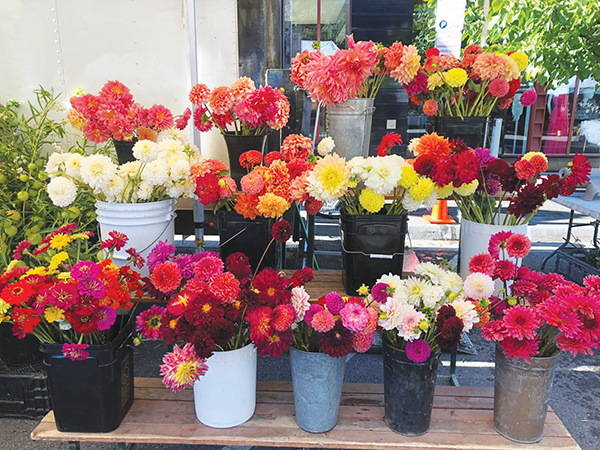 Displaying multiple levels of flowers with tiered shelving helps adds visual interest and makes a dense display of flowers more accessible to customers.
Displaying multiple levels of flowers with tiered shelving helps adds visual interest and makes a dense display of flowers more accessible to customers.
We often transfer the stems into a different can than the market bucket so they are displayed in a vase that aligns with the stem lengths. Also, we want it to be easy to pull stems out of the buckets. Some things get tangled up very easily so we restock them more often; others you can fill quite full.
We of course sell a ton of sunflowers, lilies, peonies, and dahlias. But we also sell everything we can from funky perennials like cardoon, Armenia basket flower, daisies, but also simple annuals like bachelor buttons, zinnias, nigella, or dara. We could sell way more greenery if we had it, but shrubs grow slowly for us and we need them for our large bouquets. But we even sell ornamental grasses, millet, you name it we will put it out.
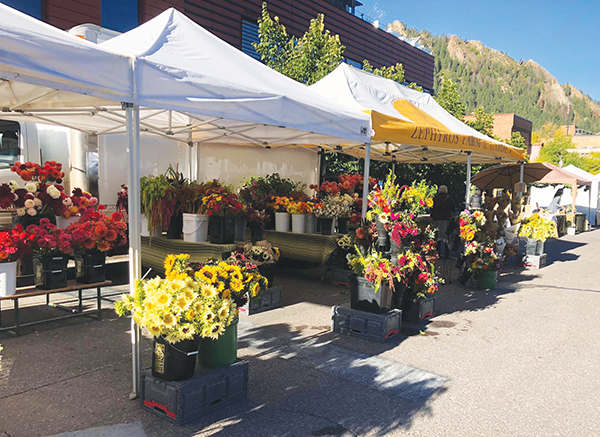 Over the years, the author’s farmers market display has gone from 10 feet of booth space to 50. They do three markets a week.
Over the years, the author’s farmers market display has gone from 10 feet of booth space to 50. They do three markets a week.
Stems are priced based on availability and quality, and we sell almost nothing for less than $1 a stem, usually $2 to $3. Big flowers can be $5 to $7, depending on where it came from, greenhouse or field, and the quality. Just to plant it, harvest it, put it in a cooler, bring it to market, display it, and educate people about it justifies the cost. The first sunflowers out of a high tunnel go for a lot more than those in the middle of August.
Part of why we like growing unique perennials is how they sell at the market. Make sure to tell people that you will only have this flower for a few weeks and they will try it. Focusing on stems with longer vase life helps make the stem option more popular. Dahlias are the notable exception for us, but we are sure to set expectations of vase life. If they buy a dinner plate dahlia, make sure they know they last a day or three if they are lucky. The other great thing about having stems is that if a marigold is broken in a bouquet you can simply grab one to throw in. The customers love when you pick up on those details.
We count all the stems and bouquets, and wrap them in brown butcher paper. We get rolls that are 900 feet long and have a butcher paper holder which easily rips off the right size for the amount of flowers. We do not offer bags with water and rubber bands; we do not have the time as we usually have a line.
Farmers market strategies
We offer to hold people’s paid for bouquets in the back of the truck in water in the shade so they can come back at the end of the day to pick them up. This is popular, and without it we would sell a lot less. People can shop or go out to lunch and know their flowers are still fresh. Otherwise, we tell them to get them home right way, cut them and place them in clean cool water.
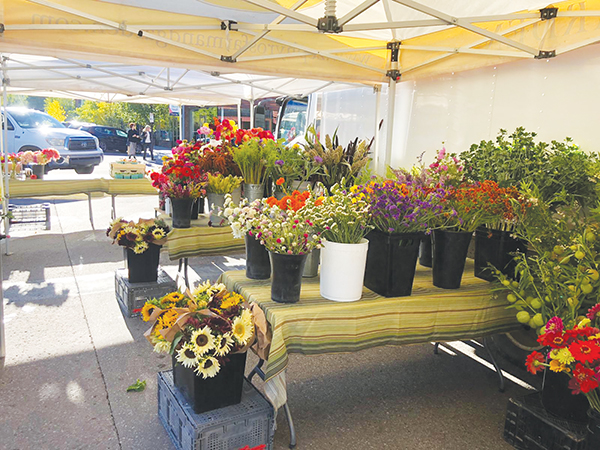 We have always sold stems at the farmers market. We love growing unique perennials and bring a few buckets and people often buy stems to play with on their own. We usually only bunch flowers and sell them pre-bunched if we have a lot of something. Otherwise we have a list or a sign on each bucket indicating the cost by the stem. Also, having the stems allows people to buy a few more stems to add to a bouquet. We often transfer the stems into a different can than the market bucket so they are displayed in a vase that aligns with the stem lengths. Also, we want it to be easy to pull stems out of the buckets. Some things get tangled up very easily so we restock them more often; others you can fill quite full.
We have always sold stems at the farmers market. We love growing unique perennials and bring a few buckets and people often buy stems to play with on their own. We usually only bunch flowers and sell them pre-bunched if we have a lot of something. Otherwise we have a list or a sign on each bucket indicating the cost by the stem. Also, having the stems allows people to buy a few more stems to add to a bouquet. We often transfer the stems into a different can than the market bucket so they are displayed in a vase that aligns with the stem lengths. Also, we want it to be easy to pull stems out of the buckets. Some things get tangled up very easily so we restock them more often; others you can fill quite full.
We also sell a variety of French flower cans, glass containers, and little honey jars if people are at a condo or hotel or just want something to put them in for the day. Also, suggest an old coffee cup with water in the car. Finally, if someone buys a ton of flowers, they can take a bucket if they bring it back, which they almost always do. Now we have quite a few customers who bring their own buckets which we gladly fill with water.
We accept cash, checks from a local bank, and credit cards and debit cards will always get you more sales. Flowers are often an impulse buy, and if they can put it on the card then they can throw in a couple bunches of sweet peas, too, why not. The small bouquets are right where they check out so they can easily add a few small purchases at the end.
Make sure you have people smell the fragrant flowers, and give little kids broken flowers or ones that won’t last long. When you describe a flower and its vase life or what might go well with a bunch of sunflowers, speak up so other people hear you. With the amount of cooking shows on TV these days people are afraid to feel stupid by asking questions about a vegetables, but this is not the same with flowers, so educate people since most don’t know many flowers beyond a sunflower.
Finally, there is often the one nay-sayer who wants to complain about price, quality, or something. Learn not to take it personally by preparing for the inevitable. Most people do not know what it takes to get blooms from seed to market. So you can let them know when you planted those flowers, how many times you had to weed them, or how they can’t get these flowers except at a local market due to vase life. But you have to do it not angry or upset.
It can be hard, so take a deep breath and do your best. Some customers just won’t get it, and you don’t need them. If someone says their flowers died when they got home, we replace them no questions asked. But to do this you must understand vase life, your flowers and your market. If it happens week after week then we stop selling to them.
CSA
We also market flowers through a CSA, what some call a subscription service. You can make the season as long as makes sense for you and your production. We have done a spring season and then a summer season. Sometimes you can do it monthly, depending on what you want to take on.
Customers sign up through our website which takes care of payments. Originally, we started with emails, invoices and checks. Of course, the spirit of a CSA is that they pay all at once in the spring for a share of the seasons products. We offer a monthly payment plan, but keep in mind the added bookkeeping headache. The CSA is a way to sell to our local community. For signing up for the whole season, they get a deal compared with market bouquets. We offer two sizes, almost all get the small size. For our 18-week CSA, the small size is $306 for on-farm pickup or $360 for off-farm. The large size is $720 for on-farm pickup or $760 for off-farm pickup.
For on-farm pick up, the bouquets are wrapped and in water in the cooler. Customers know where to get their flowers and can come whenever. People know if they have not come in two days, the bouquet may not be there or will have been moved and difficult to find. Of course, if you want to set parameters, do so.
We also have an off-farm location where customers pay more for delivery. There are many ways to do this- a members garage with a cooler or a store that is willing to do pick-up. For a while we had a fruit stand/café that worked well. They kept them in the back in their cooler. In exchange they got a bouquet a week. A checkout person would retrieve the flowers.
Now we are in a different location about an hour away. We have teamed up with a liquor store. We sell plants out front in the spring so we got to know them. It’s an odd combo, but they are open early and late, giving people plenty of time to get their bouquets. They have to pick it up that day, otherwise staff take them home. The owner gets a bouquet for his wife and it has worked great. So be creative in terms of what might work. A bottle of wine and a bouquet at the end of a day who would say no.
Make sure the two bouquet sizes are clearly differentiated. We still have problems, even with names written on the paper. Each CSA has to figure out the nuances of its particular situation for the grower and customers. We are more hands off. In terms of the flowers, we use what we have a lot of. We set up a specific table to use certain flowers and elements. So they mostly look similar.
The large ones are still done in our unique fashion. But the regular sized bouquets can be made quickly and with product that you have a lot of at the time. The great thing compared to a vegetable CSA where people have to have a certain vegetable is that there are rarely people who have to have a certain flower. They look forward to dahlias or peonies, but no one quits because they did not get veronica in their bouquet this season. On occasion if we are short for time and overwhelmed, they may get a straight bunch of sunflower, or dahlias. Sometimes they get extra bouquets of sweet peas if we have an abundance. Never had a problem with this.
Communication is personal. Some people like to send an email every week and talk about what is in the bouquet, how to take care of it, and which flowers may have a shorter vase life. Updates on the farm, farm life, and what’s coming up are all great things to cover. Our CSA is not huge so they are lucky to get a few emails a year.
If you can find the time, I think it is great to do and allows you to promote others products or events on your farm. We just do not make the time sadly, and perhaps if we did we would have more retention, but all in all we get a lot of repeat customers. On a final note, make sure to sell the CSAs by Mother’s Day at the latest if not Valentine’s Day. We have multiple people give them as gifts each year. It’s a great way to promote the CSA.
From CSA I will take a slight diversion into a pet peeve of mine: consignment. I refuse to consign flowers. I think it always goes badly. That being said, if you have the perfect situation it could in theory work. But the person who has the shop, café, or whatever, really has to be invested. With consignment they rarely care as much as you would. We have tried a few different times and places, and it just led to a lot of work ending in someone else’s compost. So from my standpoint it is a no-go period. I would rather sell them bouquets or stems wholesale and let them make the mark-up and know what I have sold.
Don Lareau has been farming flowers organically for twenty years on the western slope of Colorado with his wife Daphne Yannakakis, and an amazing crew of farmers. Currently on sabbatical in the Netherlands he is studying agroforestry, agrovoltaics and agroecology while pursuing a Masters in Organic Agriculture. He has been on the board of the Organic Farming Research Foundation (OFRF), and when not farming he can be found in the deep powder at the top of a mountain somewhere.

